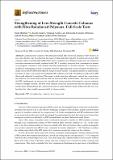Por favor, use este identificador para citar o enlazar a este item:
http://hdl.handle.net/10261/222411COMPARTIR / EXPORTAR:
 SHARE SHARE
 CORE
BASE CORE
BASE
|
|
| Visualizar otros formatos: MARC | Dublin Core | RDF | ORE | MODS | METS | DIDL | DATACITE | |

| Título: | Strengthening of Low-Strength Concrete Columns with Fibre Reinforced Polymers. Full-Scale Tests |
Autor: | Martínez, Sonia CSIC ORCID; Diego, Ana de CSIC ORCID ; Castro, Viviana Jacqueline CSIC ORCID; Echevarría, Luis CSIC ORCID ; Barroso, J. CSIC; Rentero, Gabriel CSIC; Soldado, Rafael P. CSIC; Gutiérrez Jiménez, José Pedro CSIC ORCID | Palabras clave: | FRP Strengthening Columns Tests Large-scale |
Fecha de publicación: | 31-oct-2020 | Editor: | Multidisciplinary Digital Publishing Institute | Citación: | Infrastructures 5(11): 91 (2020) | Resumen: | Confinement of columns with externally bonded fibre reinforced polymers (FRP) sheets is an easy and effective way of enhancing the load carrying and strain capacity of reinforced concrete (RC) columns. Many experimental studies have been conducted on cylindrical small-scale un-reinforced concrete specimens externally confined with FRP. It is widely accepted that confinement of square or rectangular columns is less efficient than the confinement of circular columns. The theoretical models for rectangular sections are mostly based on approaches for circular columns modified by a shape factor, but the different models do not give similar results. This paper presents an experimental program on large-scale square and rectangular RC columns externally strengthened with carbon FRP sheets and subjected to axial load. The main variables were the side-aspect ratio of the cross-section, the radius of curvature of the corners, and the amount of FRP reinforcement. The results show that the FRP confinement can increase the strength and strain capacity of rectangular concrete columns with low strength concrete. The FRP hoop ultimate strain was much lower than the material ultimate tensile strain obtained from flat coupon tests and the strain efficiency factor achieved in the tests was less than the value usually recommended by design guides. | Descripción: | This article belongs to the Special Issue Selected Papers from the REHABEND 2020 Congress. | Versión del editor: | https://doi.org/10.3390/infrastructures5110091 | URI: | http://hdl.handle.net/10261/222411 | DOI: | 10.3390/infrastructures5110091 | E-ISSN: | 2412-3811 |
| Aparece en las colecciones: | (IETCC) Artículos |
Ficheros en este ítem:
| Fichero | Descripción | Tamaño | Formato | |
|---|---|---|---|---|
| 2020-Infrastructure_publicado.pdf | 3,26 MB | Adobe PDF |  Visualizar/Abrir |
CORE Recommender
SCOPUSTM
Citations
6
checked on 25-abr-2024
WEB OF SCIENCETM
Citations
6
checked on 28-feb-2024
Page view(s)
115
checked on 30-abr-2024
Download(s)
240
checked on 30-abr-2024
Google ScholarTM
Check
Altmetric
Altmetric
Este item está licenciado bajo una Licencia Creative Commons

